
Liberty ships were a class of cargo ship built in the United States during World War II under the Emergency Shipbuilding Program. Although British in concept, the design was adopted by the United States for its simple, low-cost construction. Mass-produced on an unprecedented scale, the Liberty ship came to symbolize U.S. wartime industrial output.
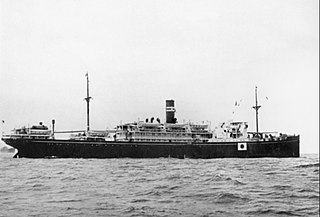
Montevideo Maru was a merchant ship of the Empire of Japan. Launched in 1926, it was pressed into service as a military transport during World War II. It was sunk by the American submarine USS Sturgeon on 1 July 1942, drowning 1,054 people, mostly Australian prisoners of war and civilians who were being transported from Rabaul, the former Australian territory of New Guinea, to Hainan. The sinking is considered the worst maritime disaster in Australia's history. The wreck of the Montevideo Maru was discovered on 18 April 2023.

Goya was a Norwegian motor freighter used as a troop transport by Nazi Germany and sunk with a massive loss of life near the end of World War II.

SS Deutschland was a 21,046 gross registered ton (GRT) German ocean liner of the HAPAG line. It was sunk in a British air attack on May 3, 1945.

SS Marine Electric was a 605-foot bulk carrier that sank on 12 February 1983, about 30 miles off the coast of Virginia, in 130 feet of water. Thirty-one of the 34 crew members lost their life due to hypothermia; the three survivors endured 90 minutes drifting in the frigid waters of the Atlantic. The wreck resulted in some of the most important maritime reforms in the second half of the 20th century. The tragedy tightened inspection standards, resulted in mandatory survival suits for winter North Atlantic runs, and helped create the now famous Coast Guard rescue swimmer program.
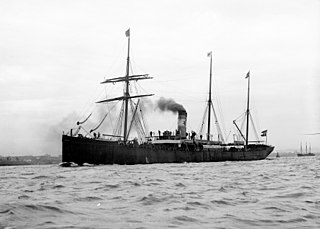
SSNorge was a transatlantic ocean liner that was launched in 1881 in Scotland, and lost in 1904 off Rockall with great loss of life. Her final voyage was from Copenhagen, Kristiania and Kristiansand, bound for New York, carrying passengers many of whom were emigrants. It was the biggest civilian maritime disaster in the Atlantic Ocean until the sinking of Titanic eight years later, and is still the largest loss of life from a Danish merchant ship.
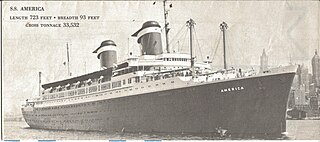
SS America was an ocean liner and cruise ship built in the United States in 1940 for the United States Lines and designed by the noted American naval architect William Francis Gibbs. It carried many names in the 54 years between its construction and its 1994 wreck: SS America ; troop transport USS West Point; and SS Australis, Italis, Noga, Alferdoss, and American Star. It served most notably in passenger service as America and the Greek-flagged Australis.
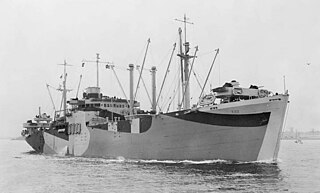
Type C1 was a designation for cargo ships built for the United States Maritime Commission before and during World War II. Total production was 493 ships built from 1940 to 1945. The first C1 types were the smallest of the three original Maritime Commission designs, meant for shorter routes where high speed and capacity were less important. Only a handful were delivered prior to Pearl Harbor. But many C1-A and C1-B ships were already in the works and were delivered during 1942. Many were converted to military purposes including troop transports during the war.
German submarine U-596 was a Type VIIC U-boat built for Nazi Germany's Kriegsmarine for service during World War II. She was laid down on 4 January 1941 by Blohm & Voss in Hamburg as yard number 572, launched on 17 September 1941 and commissioned on 13 November under Kapitänleutnant Gunter Jahn. He was replaced on 28 July 1943 by Oberleutnant zur See Victor-Whilhelm Nonn who was superseded by Oblt.z.S. Hans Kolbus in July 1944.
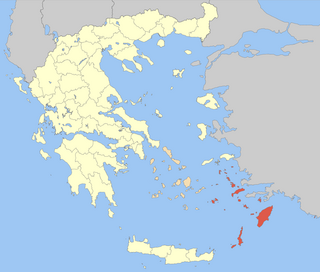
The Dodecanese campaign was the capture and occupation of the Dodecanese islands by German forces during World War II. Following the signing of the Armistice of Cassibile on 3 September 1943, Italy switched sides and joined the Allies. As a result, the Germans made plans to seize control of the Dodecanese, which were under Italian control. The Allies planned to use the islands as bases to strike against German targets in the Balkans, which the Germans aimed to forestall.

The SS Cawarra was a paddle-steamer that sank on 12 July 1866 in Newcastle harbour, New South Wales, Australia sending sixty people to their deaths. The sinking was one of the worst maritime disasters in Australian history.

HMS Sickle was a third-batch S-class submarine built for the Royal Navy during World War II. Completed in 1942, she made her initial war patrol off the Norwegian coast. Sickle then sailed to Gibraltar, from where she conducted one patrol, then to Algiers, French North Africa. From 10 May to 10 October, the boat patrolled the Gulf of Genoa five times and sank a German submarine as well as three minesweepers and an escort ship. She then moved to Beirut, French Lebanon, and conducted two patrols in the Aegean Sea, sinking three caïques and a merchant ship, in addition to landing resistance operatives in Greece.
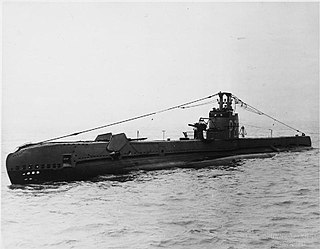
HMS Sahib was a third-batch S-class submarine built for the Royal Navy during the Second World War. She was launched on 19 January 1942 and commissioned on 13 May 1942. She was the only British naval vessel to bear the name Sahib.

HMS Sportsman was a third-batch S-class submarine built for the Royal Navy during World War II. Completed in 1942, she spent most of the war serving in the Mediterranean Sea. After an initial patrol off Norway, she sank the heavy transport Général Bonaparte in the Mediterranean in 1943 and missed a French oil tanker. She was heavily damaged after a mistaken attack by an Allied bomber, and was sent east after repairs to participate in operations in the Black Sea. After the operation was cancelled, Sportsman patrolled the Aegean Sea, sending several Greek and German ships to the bottom. She sank the German transport SS Petrella in early 1944 despite it being clearly marked as a prisoner-of-war ship, killing 2,670 out of 3,173 Italians aboard. Sportsman sank several more ships, and suffered minor damage when she was detected and sighted while attempting to attack a convoy.
The SS Gaetano Donizetti was an ex-Italian merchant motorship, captured by Nazi Germany for war use then destroyed by HMS Eclipse on 23 September 23, 1943 in the eastern Aegean Sea, taking to the bottom its munitions and killing 1,800 people on board: 1,576 Italian prisoners of war significantly overcrowded aboard, 220 German guards, and a small crew.
SS Petrella was a German merchant ship, which was torpedoed and sunk on 8 February 1944, north of Souda Bay, Crete, killing some 2,670 of the Italian POWs aboard.

Sinfra was a cargo ship built in 1929 as Fernglen by Akers Mekaniske Verksted in Oslo, Norway, for a Norwegian shipping company. The ship was sold to Swedish owners in 1934 and to a French company in 1939, on the last occasion having her name changed to Sinfra.
SS Flying Lark was a ship built in Fredrikstad, Norway in 1915 as the banana boat SS Honduras. Over a 43 year career that spanned oceans and seas the world over she had 10 owners, eight names and a succession of different managers.

Aristotelis ("Telis") Zervoudis is a professional diver from Greece.
















